
|
Sale 31
Pre-Long Beach Coin Auction
| Lot |
Photo |
Description |
Realized |
Lot 1208 |
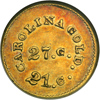 |
August Bechtler, 1 DOLLAR CAROLINA, 27 gr. 21 carats. NGC graded MS-61. Boldly struck in natural grennish color gold and delicatly toned with plenty of mint luster peeking thru. NGC reports 19 in this grade with 4 in MS-63
Not only was the Bechtler family one of the most prolific producers of private gold coinage on the eastern seabord but they also were skilled watchmakers and even experimented with the production of cutting edge firearms. The long run of gold coins produced by this firm was supplied by the gold found in the Piedmont region of North Carolina and Georgia, a gold rush eclisped by the magnitude of the 1848 California Gold Rush.
Estimated Value $2,500 - 3,000.
View details and enlarged photos
| Realized
$3,910 |
Lot 1209 |
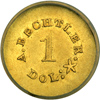 |
August Bechtler, 1 DOLLAR CAROLINA, 27 gr. 21 carats. SEGS graded MS-61. Well struck with subdue mint luster and some hairline marks are noted on the reverse. Our grade is AU-55 (PCGS # 10040) .
Estimated Value $2,000 - 2,200.
View details and enlarged photos
Check results on similar lots
| Realized
$2,185 |
Lot 1210 |
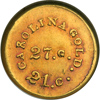 |
August Bechtler, 1 DOLLAR CAROLINA, 27 gr. 21 carats. NGC graded AU-58. Well struck and delicately toned. We note a few light tar streaks that were present during striking. Pop of 64 with 65 rated better.
Estimated Value $2,000 - 2,500.
View details and enlarged photos
| Realized
$2,645 |
Lot 1211 |
 |
1851 U.S. Assay Office $50 "slug", 880 THOUS. Reeded edge. Ex-Stacks/Superior Auction of the Charles Kramer Collection, Dec. 1988, Lot 929. Breen-7706, Kagin-5. Type with "880 Thous." in relief. This specimen has the sharpness of Uncirculated but has been cleaned. As mentioned in the earlier catalog, some reverse edge dents have been "improved" with a bit of creative engineering (PCGS # 10211) .
Estimated Value $20,000 - 30,000.
View details and enlarged photos
Check results on similar lots
| Unsold |
Lot 1212 |
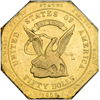 |
1852 U.S. Assay Office $50 "slug", 887 THOUS. Reeded edge. PCGS graded MS-62 PQ. Here offered is a fabulous and memorable slug. This incredible new discovery coin has resided in the collection of a Maharaja since the 1950s and is just now seeing the light of day, to the joy of all numismatists. Type with "887 THOUS." in relief. Breen-7709, Kagin-11. The lower part of the eagle, the shield and the rocky crag below are ill defined due to striking weakness. This single aspect of manufacture is more than made up for by the total originality of the coin. The surfaces are covered with satiny mint luster in lovely California yellow gold. The engine turning and filigree design on the reverse is essentially complete as are the obverse legends. These details combine to provide a coin of outstanding beauty and one of great importance in the history of California's gold discoveries and the American West. Population 1, and the only Mint State specimen this far graded by PCGS! (PCGS # 10217) .
Estimated Value $30,000 - 40,000.
View details and enlarged photos
Check results on similar lots
| Realized
$138,000 |
Lot 1213 |
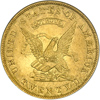 |
1853 U.S. Assay Office $20 Gold, 900 THOUS. PCGS graded MS-61. This is an interesting series with many varieties to enjoy. On this specimen, the top serif of the I in United, the top left extension of the E in America and the lower left portion of the E in Twenty, are missing. The first zero in 900 is clearly overstruck. Considerable mint luster remains and the strike is quite decent. Some obverse hairlines are noted as well as some edge scrapes on the reverse at the right side. Pop 19 with 61 finer (PCGS # 10013) .
Estimated Value $6,500 - 7,000.
View details and enlarged photos
Check results on similar lots
| Realized
$7,130 |
Lot 1214 |
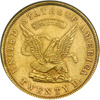 |
1853 U.S. Assay Office $20 Gold, 900 THOUS. NGC graded MS-61. A well struck and well perserved example that radiates with frosty mint luster. We note a few minor edge bumps which undoubtedly kept this beauty from grading much higher. O fht two major varieties for the 1853 U.S. Assay Office $20, the "884" and "900", the "900" is seen much more frequently. Therefore this coin presents the perfect opportunity to acquire a very choice example of a U.S. Assay Office $20. NGC population of 25 with 39 in MS-62, 18 in MS-63, 11 in MS-64 and 2 in MS-65.
Estimated Value $6,500 - 7,000.
View details and enlarged photos
| Realized
$6,900 |
Lot 1215 |
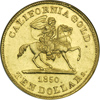 |
1850 Baldwin & Co. (San Francisco) $10 Gold. NGC graded MS-64. A fabulous example of one of the most desirable and most recognizable of all Territorial gold coins. The Vaquero, or "horseman" design captures the imagination of any numismatist. The reverse design was similar to the existing United States eagles. Curiously, because the obverse was so recognizable, the coin did not find the wide acceptance as a design more closely resembling the regular issue gold coins of the United States, and hence, the obverse die was changed in 1851 to resemble a Liberty Eagle.
This particular example boasts stunning frosty mint luster with fully struck devices in natural light gold with a slight greenish tinge. A foremost opportunity to acquire a very important numismatic treasure that may not be repeated for years to come. NGC reports this 1 example in MS-64 with 1 higher by a point.
The banking firm of Baldwin and Company was effectively crushed by a wandering eccentric who called himself James King of William. Mr. King was a muckracking political journalist from Washington D.C. for the Daily Globe until he realized better opportunities were to be found in San Francisco with the beginnings of the Gold Rush. Thus King found his way to the mining district by late 1848. Being a sagacious fellow, King soon determined that digging for gold was hard work, and it would be far easier to buy, sell or lend gold dust than to dig for it. He became one of the partners in the banking firm of Samuel J. Hensely and in several successive firms, buying gold dust to sell to coiners at high profits, starting first at Sutter's Mill, then Sacramento, and later on his own in San Francisco. However, his bank manager embezzled everything, leaving him penniless. King was envious of the profits being made by the likes of Baldwin & Co. and other private coiners of the period, and thus hatched a plot to make himself rich at their expense. King knew, as did everyone else, that the private coiner's output tended to run slightly below full bullion value, and unlike everyone else, King decided to define this as dishonestly instead of seinorage or technical limitations. Accordingly, on March 21, 1851 King sent a parcel of Baldwin, Schultz and DuBosq coins to his friend Augustus Hubert, United States Assayer, for testing. Predictably, the assays rated them from 97% to 99% of face value. On March 28, 1851 King sent the figures to all local newspapers, creating one of the biggest scandals of the period, and setting into motion corrosive attacks on these private firms. Thereafter, bankers (like King) would only pay 80¢ on the dollar for private gold coins, at a manifestly absurd discount they bought them in quantity from panicked holders, to resell at a high profit to Humbert for recoinage into octagonal $50's. This action unquestionably worsened the economic depression which immediately followed, and may have cause it, by creating a coin shortage and destroying public confidence. Not that King's action brought him the vast wealth he craved: He continued in the banking business only to fail again and again. King returned to what Kagin calls "crusading journalism" which attacks on various immorality and corruption. his final attack was on County Supervisor James P. Casey, who King exposed as having been in Sing Sing Prison prior to his governmental post. Casey was so enraged he shot King on May 14, 1856, and King died a few days later. The outraged citizens formed a vigilante committee and dragged Casey out of jail (where he had run for protection), and hung him from the nearest tree. (See Breen's Encyclopedia and Kagin's work on Territorial Gold coins for more) (PCGS # 10028) .
Estimated Value $150,000 - 175,000.
View details and enlarged photos
Check results on similar lots
| Realized
$195,500 |
Lot 1216 |
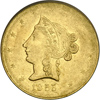 |
1855 Wass, Molitor & Co. (San Francisco) $10 Gold. PCGS graded AU-53. This specimen is from the Treasure of the S. S. Central America, very well documented in several publications on the subject. Breen- 7927, the second five of the date on a small raised circular disc. The center portion of the obverse is comparitively well struck, but for the stars from about 10 o'clock to 3 o'clock which are quite weak or not visible at all. The reverse is softly struck as all of this type are, but all design details are visible. Housed in a PCGS slab with the special Central America gold foil insert. An important artifact of early California history. Pop 10 with only 4 pieces in higher grade.
Estimated Value $25,000 - 30,000.
S.S. Central America Treasure.
View details and enlarged photos
| Unsold |
Lot 1217 |
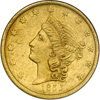 |
1855 Kellogg & Co. (San Francisco) $20 Gold. NGC graded MS-60. Struck in natural greenish-yellow gold, this desirable uncirculated example contains numerious small marks from contact with other coins. A very high grade example and among the finest we have handled in years. NGC reports only 5 in this grade with 1 in MS-61 and 2 in MS-62. A very popular Territorial issue and much scarcer than the 1854 issue.
When the U.S. Assay Office closed operations, no private firm was striking gold. The San Francisco Mint opened in 1854, but because of a shortage of parting acids could not yet completely fulfill the local demand and this shortage was taken up by Kellogg & Co.
Estimated Value $9,000 - 11,000.
View details and enlarged photos
| Unsold |
Lot 1218 |
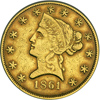 |
1861 Clark, Gruber & Co. (Denver, Colorado) $10 Gold. PCGS graded EF-45. A pleasing example with the normal light marks in the exposed fields associated with this issue and grade. The rims are clean and there are no single marks worthy of note, all lightly toned. PCGS reports 11 with 53 rated better (PCGS # 10141) .
Estimated Value $3,500 - 4,000.
View details and enlarged photos
Check results on similar lots
| Realized
$4,255 |
Lot 1219 |
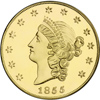 |
1855 Kellogg & Co (San Francisco) $50 Gold Commemorative Restrike. PCGS graded Gem Proof. This coin was struck in San Francisco Sept. 6, 2001 from transfer dies made from the original 1855 Kellogg & Co dies. The gold in the planchet came from Kellogg and Humbert ingots salvaged from the wreck of the S.S. Central America treasure. Less than 5000 were struck. Graded Gem Proof by PCGS and housed in their special holder with the commemorative insert label showing the date struck which matches the date counterstamped on the reverse of the coin above the eagle. A similar specimen was sold in our Feb. 2005 auction where it realized a total of $3335.
Estimated Value $2,500 - 3,000.
From gold bars recovered from the S.S. Central America.
View details and enlarged photos
| Realized
$2,640 |
|
|